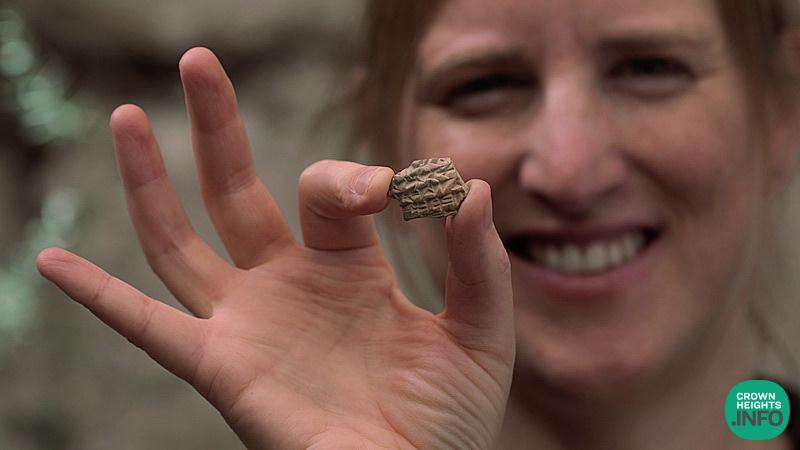
Extremely Rare and Historic Pottery Fragment Uncovered in Excavations in Jerusalem
Today, we are revealing for the first time a tiny pottery fragment, exceptionally rare, bearing an inscription in cuneiform script written in the Akkadian language, dating back about 2,700 years. The inscription provides rare evidence of correspondence between the court of the King of Assyria and the King of Judah. This extraordinary and unique find was uncovered near the Western Wall of the Temple Mount, north of the City of David – the only Assyrian inscription from the First Temple period (8th–7th centuries BCE) ever found in the city.
The rare discovery was made during an archaeological excavation conducted by the Israel Antiquities Authority, in collaboration with the City of David Foundation, and directed by Dr. Ayala Silberstein of the Israel Antiquities Authority. The excavation takes place within the Jerusalem Archaeological Park – Davidson Center, managed by the Company for the Reconstruction and Development of the Jewish Quarter. The inscription was deciphered in cooperation with Dr. Philip Vukosavović and Dr. Anat Cohen-Weinberger of the Israel Antiquities Authority, together with Dr. Peter Zilberg of Bar-Ilan University.
The tiny fragment, measuring about 2.5 cm, was discovered during wet-sifting at the “Archaeological Experience” in the Tzurim Valley National Park – a joint project of the Israel Nature and Parks Authority and the City of David Foundation.

The discovery of the artifact in a controlled archaeological excavation generated great excitement.
Moria Cohen, a staff member at the “Archaeological Experience” in the Tzurim Valley, described the moment of discovery:
“I was sifting the soil and suddenly noticed a potsherd with a strange pattern. I looked closely, and it seemed like cuneiform script – which felt so unlikely, because even though many fascinating finds have been uncovered here, we’ve never found anything like this. I checked again, and when I realized it wasn’t decoration but actual cuneiform writing – I screamed with excitement. Everyone gathered around, and I called Ayala, the excavation director, who was thrilled by the find. The thought that after 2,700 years I’m the first person to touch this fragment – it’s incredibly moving. It’s truly a once-in-a-lifetime find.”
The fragment was discovered in soil that had washed to the end of the central drainage channel from the Second Temple period, likely originating from the collapse of an earlier structure from the First Temple period in an area where the drainage channel did not survive.
The site, located on the eastern slope of Jerusalem’s western hill, is one of the closest points to the Temple Mount ever excavated – a fact that grants this find significant importance for understanding the city’s urban and political development during that era.
According to Dr. Ayala Silberstein, excavation director on behalf of the Israel Antiquities Authority:
“The inscription provides direct evidence of official correspondence between the Assyrian Empire and the Kingdom of Judah. The discovery strengthens our understanding of the depth of Assyrian presence in Jerusalem and the extent of its influence on the city’s administration. It also expands our knowledge of the status of the new neighborhood that developed at that time on the slopes west of the Temple. It appears this area served as a center for high-ranking officials and ministers.”
Dr. Peter Zilberg and Dr. Philip Vukosavović believe the fragment was once part of a royal bulla – a seal impression used to authenticate an official letter or shipment from the Assyrian royal court.
“Such bullae often bore short inscriptions explaining the content or destination of the dispatch in Assyrian cuneiform, and they differ in size and shape from the local bullae known in Judah,” the Assyriologists explain.
Analysis of the inscription and its content supports the hypothesis that the sealed document dealt with a delay in the payment of a tax or other obligation. The text specifies a deadline – the first day of the month of Av – and explicitly mentions a “chariot officer” (literally, “the one who holds the reins” in Assyrian), a high-ranking figure responsible for transmitting official royal communications, known from Assyrian administrative archives.
Although the fragment does not include the name of the King of Judah to whom the message was addressed, its chronological context and partial text suggest it was sent to the court of one of the Judean kings – Hezekiah, Manasseh, or Josiah early in his reign – when Judah was a vassal kingdom under Assyria. Such items served as intermediaries between Assyrian emissaries and Judean officials, conveying official instructions and tax demands.
“While we cannot determine whether the delay was technical or politically motivated, the very existence of such an official message may indicate a point of tension between Judah and the imperial administration,” the researchers note. One possible avenue of study is that the royal seal impression was sent to Judah during the reign of Sennacherib, King of Assyria, as the characteristics of the inscription and its dating align with his reign or that of his successors – possibly echoing the biblical account of Hezekiah’s tax rebellion as described in II Kings 18:7: ‘He rebelled against the King of Assyria and did not serve him.’
Petrographic examination of the bulla revealed it was not produced in Jerusalem but sent from a distant location, likely from one of Assyria’s main administrative centers such as Nineveh, Ashur, or Nimrud.
According to Dr. Anat Cohen-Weinberger of the Israel Antiquities Authority:
“Analysis of the fragment’s composition clearly shows that the material differs entirely from local clays used in Jerusalem and southern Levantine production of pottery, bullae, or clay tablets. Its mineral composition matches the geology of the Tigris basin, where Assyria’s main cities – Nineveh, Ashur, and Nimrud – were located. A detailed chemical analysis is now underway with Dr. Judith Harlavan of the Geological Survey of Israel to determine the exact source of production.”
The researchers conclude:
“This small fragment holds enormous significance. It opens a window into the diplomatic and administrative relations between Judah and Assyria – providing the first-ever evidence of official communication between Jerusalem and the most powerful empire of its time.”














